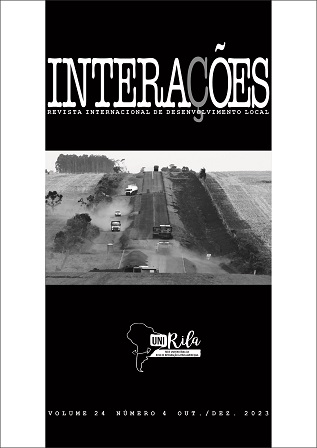Actors networks in the Bioceanic Road Corridor “Mato Grosso do Sul – Ports of Northern Chile”: diagnosis and proposal for a multilevel governance
Keywords:
Bioceanic Road Corridor, governance, South America, infrastructures integrationAbstract
The Bi-Oceanic Road Corridor connecting Brazil, Paraguay, Argentina, and Chile is a project aimed,
among other objectives, at providing new development opportunities to peripheral regions in the Tropic of
Capricorn. However, regional transformation requires more than just physical infrastructure; it particularly
necessitates effective coordination among diverse actors to achieve development. The main objective of
this document is to provide a detailed explanation of the actor network structure within the Bi-Oceanic
Highway Corridor and propose a potential governance approach that facilitates improved coordination
among participants. Through Social Network Analysis (SNA), we conducted an exploration of the participation
dynamics and decision-making among the different actors involved. Our primary findings reveal a low level of
private sector engagement, limited transnational links (with more interactions occurring among actors from
the same country), scarce connections between national and subnational/local government actors, as well
as minimal involvement of the national government in Argentina. Regarding the governance proposal, we
suggest the creation of two new committees (Social and Environmental Development, and Border Security),
the promotion of business missions with a regional integration approach, and the preservation of the progress
made by the CVB Working Group.
References
ACTA DECLARACIÓN DE ASUNCIÓN SOBRE CORREDORES BIOCEÁNICOS. Assunción, Paraguay, 2015.
ACTA DECLARACIÓN DE BRASILIA SOBRE CORREDORES BIOCEÁNICOS. Brasília, DF, Brasil, 2017.
BARROS, P. S; GONÇALVES, J. S. B. O protagonismo do Mato Grosso do Sul para a resiliência do Corredor
Rodoviário Bioceânico. Monções: Revista de Relações Internacionais da UFGD, v. 10, n. 19, p. 105-28, 2021.
BRASIL. Ministério das Relações Exteriores. Nota a la prensa n. 217. Consenso de Brasilia. Brasília, DF,
maio 2023.
COMISIÓN ECONÓMICA PARA AMÉRICA Y EL CARIBE [CEPAL]. Integración regional: hacia una estrategia de
cadenas de valor inclusivas. [s.l.]: CEPAL, 2014. Disponível em: https://www.cepal.org/pt-br/node/24749.
Acesso em: 10 jun. 2023.
COPUS, A. K.; DE LIMA, P. Territorial cohesion in rural Europe. [s.l.]: Routledge, Taylor y Francisc Group, 2015.
DANNENBERG, P.; DIEZ, J. R.; SCHILLER, D. Spaces for integration or a divide? New-generation growth corridors
and their integration in global value chains in the Global South. Zeitschrift für Wirtschaftsgeographie,
[s.l.], v. 62, n. 2, p. 135-51, 2018.
GOBIERNO DE SALTA. Tercer Foro de los Territorios Subnacionales del Corredor Bioceánico de Capricornio:
Declaración De Salta. Salta, 2023. Disponível em: https://www.semadesc.ms.gov.br/wp-content/
uploads/2023/04/Declaracion-de-Salta-Tercer-Foro-de-los-Territorios-Subancionales-el-CBC.pdf. Acesso
em: 10 jun. 2023.
DUNFORD, M.; LIU, W. Chinese perspectives on the Belt and Road Initiative. Cambridge Journal of Regions,
Economy and Society, [s.l.], v. 12, n. 1, p. 145-167, 2019.
FRANCO, L.; GONÇALVES, J. D. S. B.; ATIENZA, M.; BARROS, P. S. Redes de actores y su rol en el desarrollo
de corredores: diagnóstico y propuesta de gobernanza para el corredor bioceánico vial Mato Grosso do
Sul – puertos del norte de Chile. Brasília: Ipea, 2023. 79 p.
GRAPPI, G. Asia’s era of infrastructure and the politics of corridors: decoding the language of logistical
governance. Logistical Asia: The labour of making a world region, 2018. p. 175-98.
HOPE, A.; COX, J. Development corridors. Coffey International Development, [s.l.], n. 12, 2015.
HOWLETT, M., KEKEZ, A.; POOCHAROEN, O. O. Understanding co-production as a policy tool: Integrating
new public governance and comparative policy theory. Journal of Comparative Policy Analysis: Research
and Practice, v. 19, n. 5, p. 487-501, 2017.
KUNAKA, C.; CARRUTHERS, R. Trade and transport corridor management toolkit. [s.l.]: World Bank
Publications, 2014.
MAGENNIS, E.; CORRIGAN, J.; BLAIR, N.; BROIN, D. Ó. Planning a Dublin-Belfast Economic Corridor:
Networks, engagement and creating opportunities. Administration, [s.l.], v. 69, n. 4, p. 57-82, 2021.
ÖBERG, M. Governance structure for transport corridors. Dissertation (Doctoral) – Luleå Tekniska
Universitet, 2014.
SANGUINETTI, P.; MONCARZ, P.; VAILLANT, A, ALLUB, L.; JUNCOSA, F.; BARRIL, D.; CONT, W.; Y LALANNE, Á.
Caminos para la integración: facilitación del comercio, infraestructura y cadenas globales. de valor, 2021
SCOTT, J. W. European and North American contexts for cross-border regionalism. Regional studies, v.
, n. 7, p. 605-17. 1999.
SEQUEIRA, S.; HARTMANN, O.; KUNAKA, C. Reviving trade routes: evidence from the maputo corridor.
Sub-Saharan Africa Transport Policy Program (SSATP) discussion paper, n. 14. World Bank, 2014.
TIRONI, L. F. Harmonização de regulamentos e normas técnicas no mercosul. Revista Tempo do Mundo,
[s.l.], n. 23, p. 235–53, 2020. DOI: https://doi.org/10.38116/rtm23art9
VIRGA, T.; MIRANDA, H.; DE MARCHI, B. Integração física na Amazônia sul-americana: a inclusão das
órbitas de circulação intrarregionais na agenda pública. Revista Tempo Do Mundo, [s.l.], v. 27, p. 215-46,
Downloads
Published
How to Cite
Issue
Section
License
Copyright (c) 2023 Ledys Franco, Julia De Souza Borba Gonçalves, Miguel Atienza, Pedro Silva Barros

This work is licensed under a Creative Commons Attribution 4.0 International License.
Direitos Autorais para artigos publicados nesta revista são do autor, com direitos de primeira publicação para a revista. Em virtude de aparecerem nesta revista de acesso público, os artigos são de uso gratuito, com atribuições próprias, em aplicações educacionais e não-comerciais.


